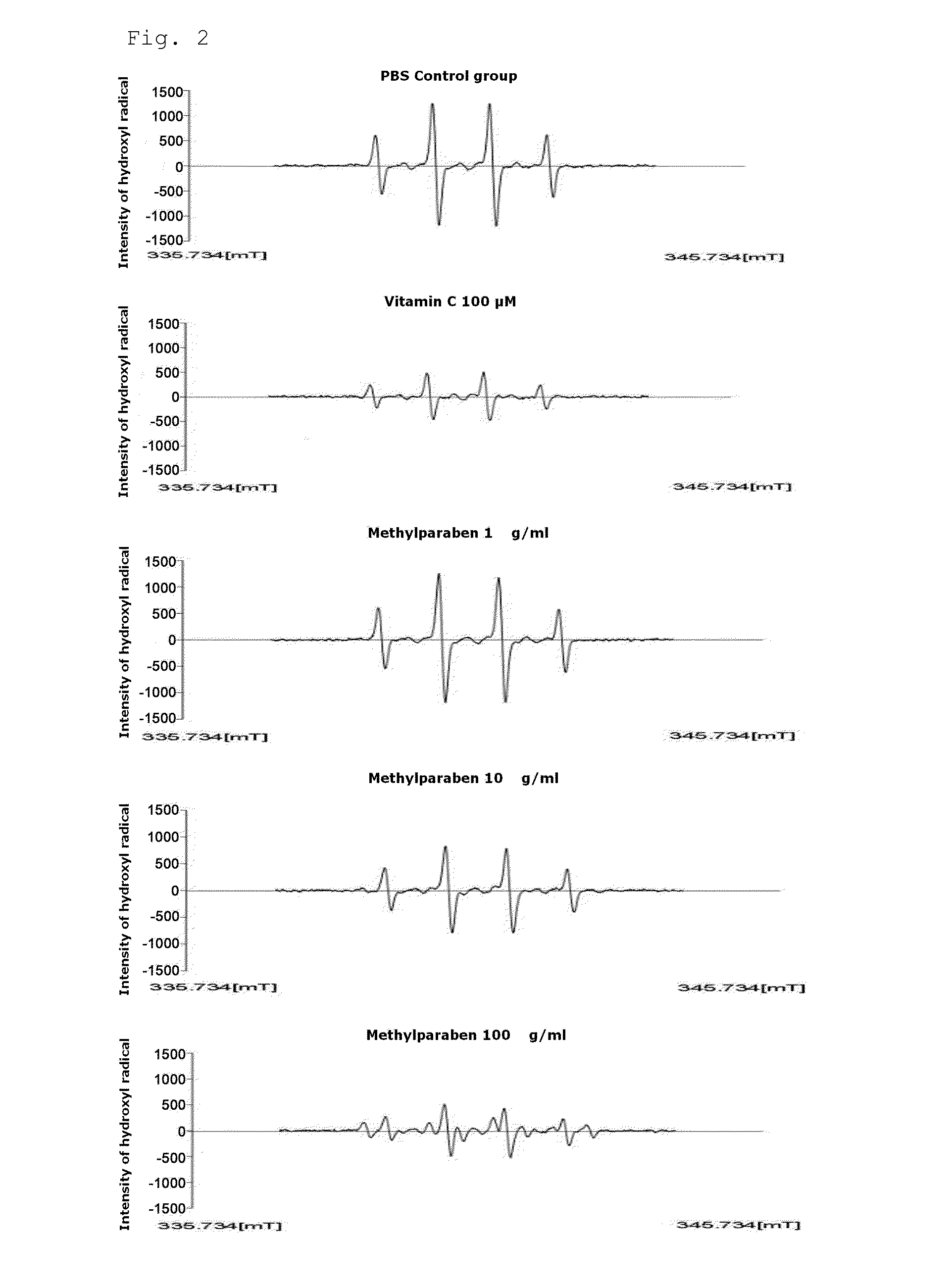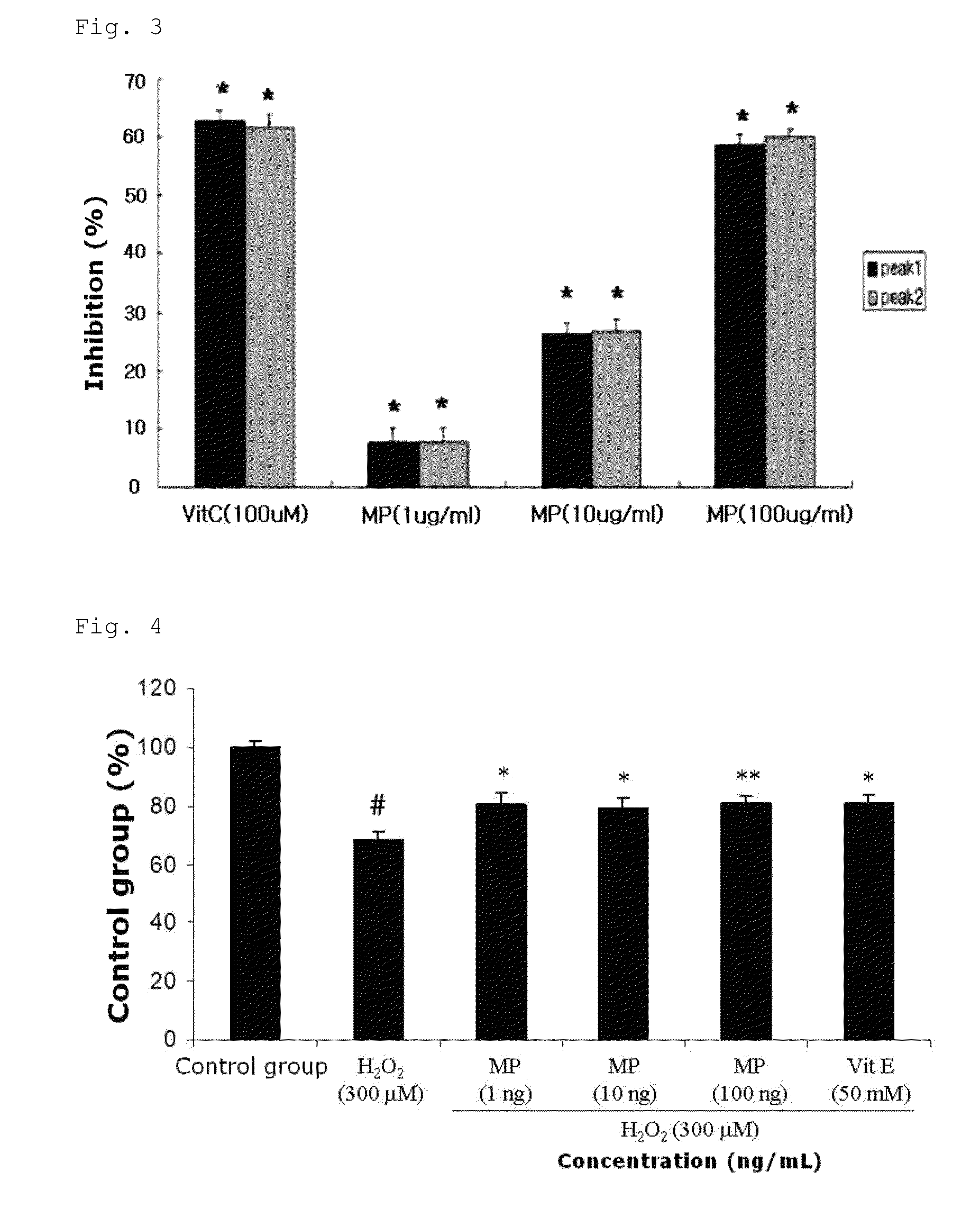Method for prevention or treatment of degenerative neurologial brain disorders
a neurologial brain and neurology technology, applied in the direction of drug compositions, biocide, nervous disorders, etc., can solve the problems of affecting the function of neurons, so as to improve the function of movement and improve the effect of memory, enhancing the deterioration of memory, and efficient us
- Summary
- Abstract
- Description
- Claims
- Application Information
AI Technical Summary
Benefits of technology
Problems solved by technology
Method used
Image
Examples
example
Example 1
Synthesis of Methylparaben
[0048]After reacting phenol and carbon dioxide at 100 atms and 125° C., sulfuric acid was added thereto to produce parahydroxy benzoate. This compound was esterified using s methanol to synthesize methylparaben (MP).
[0049]The synthesized methylparaben (MP) was analyzed by high-performance liquid chromatography (HPLC) and results thereof are shown in FIG. 1.
[0050]Further, the synthesized methylparaben (MP) was diluted in phosphate buffered saline (PBS) and used for test and analysis.
example 2
Hydroxyl Radical Removal Ability Test
[0051]In order to identify active oxygen removal ability of methylparaben (MP), Fenton reaction [H2O2+FeSO4] was performed to derive hydroxyl radicals. The derived hydroxyl radicals were entrapped by a nitrone spin trap (DMPO) and the entrapped DMPO-OH addition product was measured by an electron spin resonance (ESR) spectrometer. ESR spectrum was measured by reacting a reaction reagent [phosphate buffer solution (pH 7.4); 4.5 M DMPO 10 μl, 0.6 mM FeSO4 75 μl, 2.8 M H2O2 75 μl], methylparaben and vitamin C (VitC), then, using an ESR spectrometer (JES-FA, JEOL, Japan), and the measured results are shown in FIG. 2. In this regard, the ESR spectrometer carried out analysis using some parameters [magnetic field 340 mT, power 1.00 mW, frequency 9.19 GHz, amplitude modulation 0.2 mT, gain 200, scanning time 2 minutes, scanning width 10 mT, time constant 0.03 seconds, and temperature 20° C.].
[0052]As shown in FIG. 2, it was found from the analyzed resul...
example 3
Test for Cell Protective Activity to Alpha (α)-synuclein, Active Oxygen and Excitatory Brain Neurotransmitter
[0054]In order to identify whether methylparaben (MP) in cultured cells has cell protective effects against active oxygen, excitatory brain neurotransmitter, and α-synuclein, a cell protective activity test was performed. These materials, that is, the active oxygen, excitatory brain neurotransmitter, and α-synuclein has been indicated as a cause of extensive damage of nerve cells with respect to Parkinson's disease and other degenerative cerebral disorders.
[0055]Each well of a 96-well plate was provided with SH-SY5Y cells (5×103 cells; 10% FBS added DMEM medium) derived from human nerve cancer and cultured at 37° C. for 24 hours. After this, 1, 10 and 100 ng / ml of methylparaben (MP), 50 μM Vitamin E (Vit E) or 10 μM MK-801 was added and further cultured for 4 hours. Alternatively, as a control group, a culture solution without the addition of a drug was prepared. After cultur...
PUM
| Property | Measurement | Unit |
|---|---|---|
| pH | aaaaa | aaaaa |
| frequency | aaaaa | aaaaa |
| concentration | aaaaa | aaaaa |
Abstract
Description
Claims
Application Information
 Login to View More
Login to View More - R&D
- Intellectual Property
- Life Sciences
- Materials
- Tech Scout
- Unparalleled Data Quality
- Higher Quality Content
- 60% Fewer Hallucinations
Browse by: Latest US Patents, China's latest patents, Technical Efficacy Thesaurus, Application Domain, Technology Topic, Popular Technical Reports.
© 2025 PatSnap. All rights reserved.Legal|Privacy policy|Modern Slavery Act Transparency Statement|Sitemap|About US| Contact US: help@patsnap.com



